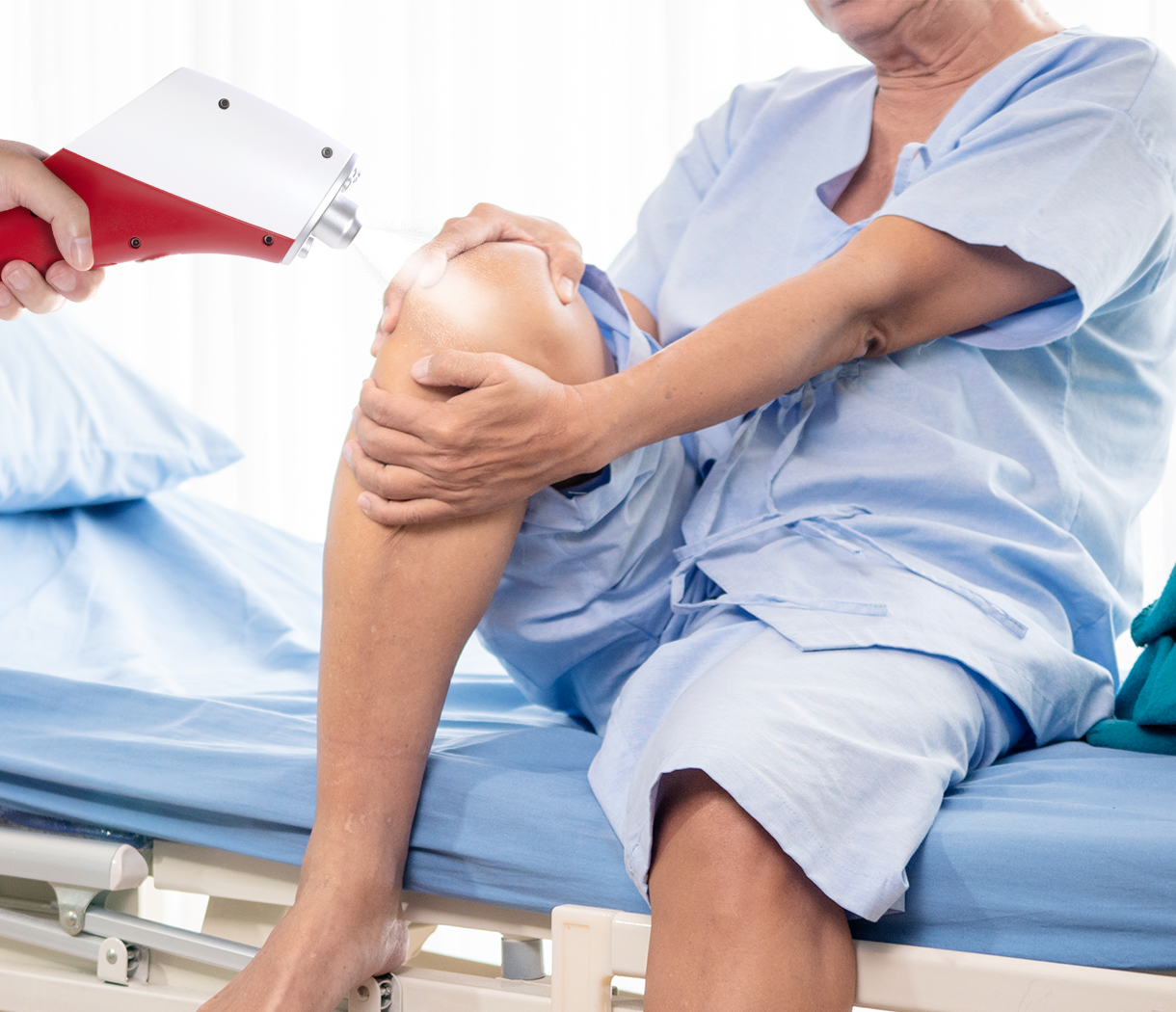Introduction
What is CO₂ Cryotherapy?
CO₂ cryotherapy is an advanced form of local cold therapy that utilizes compressed carbon dioxide gas, expelled at high velocity through a specialized device to produce rapid cooling of the skin’s surface. Reaching temperatures as low as -78°C, this procedure is designed to induce a localized “thermal shock” effect that activates a cascade of beneficial physiological responses. Unlike traditional cold packs, CO₂ cryotherapy delivers results within seconds, making it a preferred modality for precision treatment in clinical settings. The treatment duration is typically between 10 to 15 seconds per targeted area, making it efficient and time-saving.
Why Chiropractors Are Integrating CO₂ Cryotherapy
Chiropractors are increasingly adopting CO₂ cryotherapy to expand their non-invasive therapeutic toolbox. Its ability to offer rapid pain relief and anti-inflammatory benefits complements spinal adjustments and manual therapies seamlessly. The demand for drug-free, side-effect-free pain management solutions is rising, especially among patients seeking holistic approaches. CO₂ cryotherapy fits this niche, offering immediate symptomatic relief while also promoting long-term healing.
How It Complements Spinal Adjustments and Manual Therapy
The synergy between spinal manipulation and CO₂ cryotherapy lies in the ability to prime and recover soft tissues. Pre-adjustment application of cryotherapy can reduce muscle guarding, making spinal manipulations easier and more effective. Post-adjustment, it minimizes microtrauma-related inflammation, reducing soreness and optimizing healing. The result is a smoother treatment experience and improved patient outcomes.
The Science Behind CO₂ Cryotherapy
How CO₂ Cryotherapy Works
CO₂ gas is expelled through a specialized nozzle, forming a fine, pressurized jet that cools the treated area to -78°C in seconds. The rapid temperature drop induces skin thermoreceptors to activate the central nervous system’s pain modulation pathways. Concurrently, the localized cold causes vasoconstriction, reducing inflammation, swelling, and metabolic demand in tissues. Upon cessation of exposure, the body responds with vasodilation, increasing nutrient and oxygen delivery to support tissue repair.
Understanding the Thermo-Shock Effect
The thermo-shock effect refers to the body’s immediate physiological reaction to extreme cold. At the cellular level, this includes a surge in endorphins, decreased nociceptor activity, and heightened anti-inflammatory cytokines. This controlled shock interrupts pain signals and accelerates natural healing mechanisms. Thermo-shock also promotes the release of norepinephrine and other neurochemicals that enhance focus and well-being, adding to its therapeutic value.
Vasoconstriction vs. Vasodilation: Balancing Inflammation and Healing
Cryotherapy initiates a two-phase vascular response: initial vasoconstriction to minimize blood flow and inflammation, followed by vasodilation to restore circulation and promote healing. This dual-phase effect is essential in managing both acute and chronic conditions. It helps regulate cytokine activity, reducing the risk of excessive inflammation while simultaneously fueling regenerative processes.
Safety Profile and Device Technology
Modern CO₂ cryotherapy systems come with built-in safety features including temperature sensors, flow regulators, and timed spray bursts to prevent overexposure. Devices used in chiropractic clinics are CE-certified and adhere to strict safety standards. When administered by trained professionals, CO₂ cryotherapy has a low risk profile and is suitable for most patients, excluding those with cryoglobulinemia, Raynaud’s disease, or hypersensitivity to cold.

Conditions Treated with CO₂ Cryotherapy in Chiropractic Care
Acute Soft Tissue Injuries
CO₂ cryotherapy is highly effective in managing acute soft tissue injuries such as muscle strains, ligament sprains, and tendon microtears. These injuries typically present with localized inflammation, edema, and pain. The -78°C temperature of CO₂ gas induces rapid vasoconstriction, which helps reduce blood flow to the area, minimizing swelling and controlling hemorrhagic leakage from damaged capillaries. A typical application time of 10–15 seconds is sufficient to initiate analgesia and decrease muscle spindle activity, helping patients regain mobility sooner without pharmacologic intervention.
Chronic Inflammatory Conditions
Conditions such as tendinopathies, bursitis, and fasciitis benefit from the anti-inflammatory effects of repeated CO₂ cryotherapy applications. Chronic inflammation often involves persistent cytokine activity (e.g., TNF-α, IL-6) and tissue remodeling. Cold exposure reduces metabolic activity and inhibits inflammatory mediators, allowing tissues to enter a reparative state. Chiropractors often use CO₂ therapy in conjunction with therapeutic exercises and manual mobilization to accelerate long-term recovery.
Nerve-Related Disorders
Peripheral nerve conditions like radiculopathy, neuritis, or carpal tunnel syndrome can benefit from cryotherapy’s neuroinhibitory effects. By lowering the surface temperature of the skin and subdermal tissues rapidly, nociceptor signaling is suppressed, which temporarily blocks pain transmission along C and A-delta fibers. This allows chiropractors to apply manipulation techniques more comfortably and helps patients perform therapeutic movements with less discomfort.
Overuse and Sports Injuries
Athletes dealing with overuse syndromes such as medial epicondylitis or patellar tendinopathy often face prolonged healing times. The combination of CO₂ cryotherapy and chiropractic adjustments optimizes tissue repair by managing inflammation and promoting circulation through alternating vasoconstriction and vasodilation (the “thermo-shock” cycle). This treatment supports tendon remodeling and reduces downtime between training or competition.
Post-Chiropractic Adjustment Recovery
Post-adjustment soreness, sometimes referred to as “manipulation soreness,” is a common but temporary response to spinal and joint realignment. Applying CO₂ cryotherapy immediately following an adjustment helps soothe irritated tissues, decrease hypertonic muscular response, and support parasympathetic nervous system activation. Patients often report feeling more relaxed, which contributes to better treatment compliance and satisfaction.
Benefits of CO₂ Cryotherapy in Chiropractic Settings
Rapid Pain Relief and Anti-Inflammatory Effects
The cold jet emitted from CO₂ cryotherapy devices lowers skin temperature rapidly to approximately 4°C within seconds, triggering cutaneous thermoreceptors and resulting in a localized analgesic effect. Additionally, cryotherapy suppresses prostaglandin synthesis and histamine release, reducing both nociceptive pain and inflammatory swelling. This allows patients to experience quick, drug-free relief and improves their ability to tolerate manual therapy.
Drug-Free Complement to Chiropractic Adjustments
In an era of increasing awareness about opioid overuse and NSAID side effects, CO₂ cryotherapy provides a safe, non-pharmacological option for pain control. Chiropractors are embracing this technique as it aligns with holistic treatment philosophies and offers measurable outcomes without the need for systemic medications.
Enhancing Mobility and Function
By relaxing hypertonic muscles and reducing joint capsule inflammation, cryotherapy enables patients to increase range of motion more comfortably during subsequent therapeutic sessions. This makes it particularly effective when integrated into rehabilitation protocols for frozen shoulder, lumbar facet syndrome, or postural syndromes.
Improving Patient Comfort and Experience
Patients frequently describe CO₂ cryotherapy as invigorating yet gentle. Unlike ice packs or cold immersion, CO₂ treatment does not leave moisture on the skin or cause prolonged numbness. The short 10–15 second application is convenient, especially for in-clinic use. Its modern delivery system also adds a perceived value to care, improving patient trust and retention.
Faster Recovery Between Sessions
Chiropractic care often requires multiple sessions for optimal outcomes. When CO₂ cryotherapy is used adjunctively, the downtime between sessions can be minimized. The localized modulation of inflammatory and pain responses helps maintain treatment momentum and reduces the risk of exacerbating subacute symptoms, particularly in high-risk populations like athletes or patients with repetitive strain injuries.
Clinical Evidence and Chiropractor Testimonials
Peer-Reviewed Studies on Cryotherapy in Manual Therapy
There is growing clinical evidence supporting the effectiveness of cryotherapy as a complement to manual therapies like chiropractic adjustments. Several studies have shown that cryotherapy significantly reduces inflammation, pain, and muscle spasms while enhancing tissue recovery. For example, a study published in The Journal of Manual & Manipulative Therapy highlighted that cryotherapy, combined with chiropractic care, accelerates pain reduction and improves functional outcomes in patients with acute musculoskeletal injuries. Another study published in Cryobiology found that cryotherapy’s ability to reduce swelling and expedite recovery made it an invaluable tool in managing post-operative rehabilitation and soft tissue injuries, both of which are common in chiropractic patients.
Furthermore, research presented in The Journal of Sports Medicine discussed the benefits of cryotherapy in reducing muscle soreness and improving range of motion, which directly correlates to the efficacy of chiropractic adjustments. These peer-reviewed studies demonstrate that CO₂ cryotherapy isn’t just anecdotal but is backed by scientific research, reinforcing its role as an adjunctive therapy in chiropractic care.
Chiropractor Insights: “Why I Chose CO₂ Cryotherapy”
Chiropractors who incorporate CO₂ cryotherapy into their practice report significant improvements in patient outcomes. Dr. Smith, a chiropractor with over 15 years of experience, explains, “I chose CO₂ cryotherapy to provide my patients with a safe, effective, and non-invasive pain relief option. It enhances my ability to manage acute conditions quickly and aids in the recovery process following spinal adjustments.” Many chiropractors also find that CO₂ cryotherapy improves patient compliance by providing immediate relief, reducing the apprehension some patients have toward adjustments. “For patients with high levels of discomfort, cryotherapy helps them relax and prepares them for a more effective spinal manipulation. It’s also particularly useful for patients who have chronic pain conditions, allowing them to experience relief between sessions,” notes Dr. Jennifer Liu, a chiropractor specializing in sports medicine.
Case Examples and Real-World Patient Outcomes
In practice, the combination of chiropractic care and CO₂ cryotherapy has yielded positive results for many patients. One case example includes a 35-year-old patient with chronic lower back pain and sciatica. After several chiropractic adjustments, the addition of CO₂ cryotherapy provided relief from the acute flare-ups that often followed sessions. The patient reported feeling less pain and stiffness, with enhanced mobility and fewer flare-ups of sciatica. Another real-world case involves a 22-year-old college athlete suffering from patellar tendinopathy. After undergoing regular chiropractic adjustments, the athlete added CO₂ cryotherapy to his treatment plan. Over the course of a month, his tendon pain decreased, and his recovery time after training sessions improved significantly. The combined treatments allowed him to return to his sport with improved function and fewer episodes of tendonitis.

What Patients Should Expect
Treatment Experience and Sensation
Patients typically report a unique, cold sensation during CO₂ cryotherapy treatment. The -78°C CO₂ gas is applied in quick bursts (10–15 seconds) to the target area, creating an immediate “cold shock” effect on the skin. While the sensation can be intense, it is generally brief and well-tolerated. Many patients describe the experience as a “cooling” or “tingling” sensation followed by a numbing effect that helps reduce pain. This short-lived discomfort is outweighed by the rapid relief they feel post-treatment. Patients will also notice an immediate reduction in muscle tension and inflammation after the session, which may enhance their overall comfort and facilitate a more effective chiropractic adjustment.
Treatment Duration and Frequency
Each CO₂ cryotherapy session typically lasts only 10–15 seconds per treatment area, making it a quick addition to any chiropractic care routine. Most patients experience noticeable results after just one or two sessions, but the frequency of treatment depends on the severity of the condition being treated. For acute injuries, 2-3 sessions per week may be recommended initially, with treatments tapering off as recovery progresses. For chronic conditions, weekly sessions may be necessary to maintain optimal results. Patients receiving CO₂ cryotherapy as part of a comprehensive chiropractic plan may notice cumulative benefits over time, such as reduced pain, improved mobility, and faster recovery between sessions.
Are There Any Side Effects?
CO₂ cryotherapy is generally well-tolerated and associated with few side effects. The most common side effects include mild redness or irritation at the treatment site, which usually subsides within a few hours. In rare cases, patients may experience mild bruising or a slight numbing sensation that dissipates shortly after treatment. It’s essential that CO₂ cryotherapy is applied correctly by trained professionals to minimize any risk of adverse effects. Serious side effects are exceedingly rare but can occur if the treatment is improperly administered or if patients have contraindications to cold therapy, such as those with Raynaud’s disease or severe cold hypersensitivity. As always, patients should consult with their chiropractor to ensure CO₂ cryotherapy is appropriate for their specific condition.
Ideal Candidates for CO₂ Cryotherapy
CO₂ cryotherapy is most beneficial for individuals dealing with acute soft tissue injuries, chronic inflammation, and musculoskeletal conditions that respond well to cold therapy. Ideal candidates include:
- Athletes: Especially those recovering from sports injuries or muscle strain.
- Patients with chronic pain conditions: Such as join-related injuries, tendinitis, or bursitis.
- Post-surgical patients: Those recovering from joint or soft tissue surgeries.
- Individuals undergoing chiropractic care: Who seek relief from post-adjustment soreness or muscle tightness.
Patients with certain conditions, such as cold-induced hypersensitivity, Raynaud’s disease, or open wounds, may not be suitable candidates for cryotherapy. Chiropractors will conduct an initial evaluation to determine if this treatment is appropriate for each individual.
Finishing Off
CO₂ cryotherapy is proving to be an invaluable tool in chiropractic care, offering a wide range of benefits for patients and practitioners alike. Whether you are dealing with acute injuries, chronic pain, or recovering from chiropractic adjustments, CO₂ cryotherapy enhances the healing process by reducing inflammation, improving mobility, and providing rapid pain relief. Its non-invasive nature, coupled with its quick and effective results, makes it an ideal complementary therapy for chiropractic care. As the integration of cryotherapy in chiropractic settings becomes more widespread, patients can look forward to a more comprehensive, personalized treatment plan that speeds up recovery and enhances overall well-being. If you are seeking lasting relief from pain and a faster recovery between chiropractic adjustments, CO₂ cryotherapy may be the perfect addition to your healing journey. So, don’t wait for relief to be slow—experience the power of CO₂ cryotherapy today and give your body the boost it needs to heal faster and more effectively.
FAQs
Q1. Can CO₂ cryotherapy replace chiropractic adjustments?
CO₂ cryotherapy enhances chiropractic care but doesn’t replace spinal adjustments. It reduces inflammation and speeds recovery, while chiropractic adjustments focus on spine realignment and joint mobility. Together, they provide a comprehensive healing approach.
Q2. Is CO₂ cryotherapy suitable for long-term pain relief?
Yes! CO₂ cryotherapy is effective for both acute and chronic pain, like arthritis and muscle strain. It reduces inflammation and boosts circulation, offering long-term relief and complementing ongoing pain management plans.
Q3. What’s the difference between CO₂ cryotherapy and ice therapy?
CO₂ cryotherapy is much colder (-78°C), causing rapid vasoconstriction followed by vasodilation, which boosts circulation and speeds up healing. Ice therapy works slower and may not penetrate deep tissues as effectively.
Q4. Can CO₂ cryotherapy help with post-surgical recovery in chiropractic patients?
Yes! CO₂ cryotherapy supports post-surgical recovery by reducing pain and inflammation, accelerating healing, and restoring mobility. When combined with chiropractic care, it enhances overall recovery.
Q5. How does CO₂ cryotherapy support athletic recovery in chiropractic care?
Athletes benefit from CO₂ cryotherapy by reducing soreness and inflammation in muscles and joints. It speeds up recovery, allowing athletes to return to training or competition faster. Combined with chiropractic care, it optimizes mobility and addresses misalignments.
Q6. Is CO₂ cryotherapy safe for all chiropractic patients?
CO₂ cryotherapy is generally safe but not for everyone. People with conditions like cold hypersensitivity or Raynaud’s disease should avoid it. Consult your chiropractor or healthcare provider to determine its suitability for your condition.
References
Cryotherapy for the Management of Chronic Musculoskeletal Conditions: A Clinical Assessment of Pain and Function:
https://cdn.fortunepublish.com/articles/10.26502.josm.511500195.pdf
Cryotherapy with carbon dioxide hydrate enhances immediate recovery of muscle function from neuromuscular fatigue:
https://www.tandfonline.com/doi/full/10.1080/02640414.2024.2423135#d1e1908



